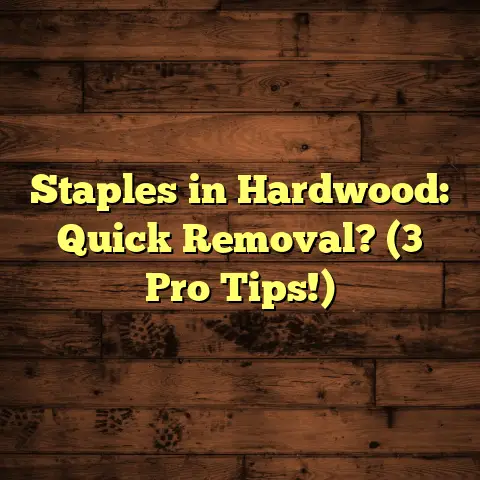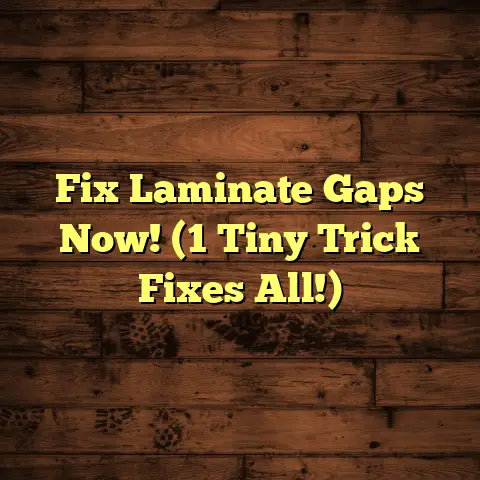Replace Floor Boards UK? (4 Hour Pro Fix!)
Did you know that nearly 30% of homeowners in the UK will encounter
issues with their floorboards at some point?
Yet many don’t realize
that a complete replacement can be achieved in just four hours!
As a flooring contractor with years of experience under my belt,
I’ve seen it all when it comes to floorboards.
From minor squeaks to
major collapses, I’ve tackled every kind of flooring woe imaginable.
And I’m here to tell you, replacing floorboards isn’t always the
nightmare it seems.
In fact, with the right know-how, it can be a
pretty straightforward DIY project.
So, grab a cuppa, and let’s dive into the world of floorboards!
I’ll walk you through everything you need to know, from identifying
problems to completing a pro-level replacement in just a few hours.
1. Understanding Floorboard Issues
Okay, let’s talk about why you might even need to replace a floorboard
in the first place.
It’s not always obvious, right?
Here are some common culprits that I see time and time again:
Warping: This is when your floorboards start to curve or bend, usually due to moisture.
Think of it like a soggy piece of cardboard.
Not ideal!Squeaking: Ah, the tell-tale sign of loose or rubbing boards.
Annoying, yes, but also a sign of underlying issues.Damage from Pests: Woodworm, beetles, and other creepy crawlies love to feast on floorboards.
This can lead to serious structural damage.-
Moisture: Leaks, spills, and damp basements can all wreak havoc on your floorboards, leading to rot and decay.
Cracks and Splits: These can happen due to age, stress, or impact.
They might seem small, but they can weaken the board over time.
Now, you might be thinking, “So what if my floorboards are a bit wonky?” Well, ignoring these issues can lead to some serious problems:
-
Health Risks: Rotting floorboards can harbor mold and mildew, which can trigger allergies and respiratory issues.
-
Safety Hazards: Weak or damaged boards can collapse, leading to falls and injuries.
-
Property Value Depreciation: Let’s face it, nobody wants to buy a house with dodgy floors.
-
Increased Repair Costs: The longer you wait, the worse the damage will get, and the more expensive it will be to fix.
In the UK, we typically use two main types of wood for floorboards:
Softwoods: Pine and fir are common choices.
They’re affordable and easy to work with, but they’re also more susceptible to damage.Hardwoods: Oak, maple, and beech are more durable and resistant to wear and tear.
They’re also more expensive, but they can last for generations.
The type of wood used in your floorboards will affect how you approach
repairs and replacements.
So, it’s important to know what you’re dealing with.
2. Assessing Your Floorboards
Alright, Sherlock Holmes, it’s time to put on your detective hat and
assess the condition of your floorboards.
Here’s my step-by-step guide:
Visual Inspection: Start by simply looking at your floorboards.
Do you see any obvious signs of damage, like warping, cracks, or stains?The Bounce Test: Walk across your floor and pay attention to how it feels.
Do any areas feel soft or spongy?
Do you notice any excessive bouncing?The Sound Check: Listen for squeaks, creaks, or groans as you walk.
These sounds can indicate loose or rubbing boards.The Moisture Meter: If you suspect moisture damage, use a moisture meter to check the moisture content of the wood.
A reading above 15% is a cause for concern.
You can pick these up for around £20-£50 at most DIY stores.The Probe Test: Use a screwdriver or awl to gently probe the wood in suspicious areas.
If the wood feels soft or crumbly, it’s likely rotten.
So, how do you know when a floorboard is repairable versus replaceable?
-
Repairable: Minor cracks, squeaks, or surface damage can often be fixed with wood filler, shims, or screws.
-
Replaceable: Significant warping, rot, pest damage, or structural weakness usually means it’s time for a replacement.
Here are some tools you’ll need for this assessment phase:
- Flashlight: To get a good look in dark corners.
- Screwdriver or Awl: For probing the wood.
- Moisture Meter: To check moisture content.
- Tape Measure: To measure the dimensions of the floorboards.
- Camera: To document the damage (helpful for insurance claims).
Remember, safety first!
Wear gloves and eye protection when inspecting
potentially damaged floorboards.
You never know what you might find lurking underneath.
3. Preparation for Replacement
Okay, you’ve assessed your floorboards and decided that a replacement
is necessary.
Now it’s time to get prepared!
First, let’s talk materials. Here’s what you’ll need:
New Floorboards: Choose a type of wood that matches your existing floorboards as closely as possible.
Consider the species, width, and thickness.Nails or Screws: Use appropriate fasteners for the type of wood you’re using.
Ring shank nails are great for added grip.-
Wood Glue: For extra bonding strength.
-
Wood Filler: To fill any gaps or imperfections.
-
Sandpaper: To smooth out the surface of the new floorboards.
-
Varnish or Sealant: To protect the wood and give it a finished look.
In the UK, you can expect to pay anywhere from £20 to £80 per square meter for floorboards, depending on the type of wood and quality.
Now, let’s talk tools. Here’s what you’ll need to get the job done:
- Safety Glasses: Protect your eyes from flying debris.
- Gloves: Protect your hands from splinters and chemicals.
- Dust Mask: Protect your lungs from dust and fumes.
- Pry Bar: For removing the old floorboards.
- Hammer: For driving in nails.
- Nail Gun (Optional): For faster and more efficient nailing.
- Hand Saw or Circular Saw: For cutting the new floorboards to size.
- Measuring Tape: For accurate measurements.
- Pencil: For marking cut lines.
- Sanding Block or Orbital Sander: For smoothing the surface of the wood.
- Paint Brush or Roller: For applying varnish or sealant.
Before you start ripping up floorboards, there are a few preparatory steps you need to take:
Measure the Area: Measure the length and width of the floorboards you need to replace.
This will help you determine how much material to order.Order Materials: Order your floorboards, fasteners, and other supplies from a reputable supplier.
I personally prefer to use local timber merchants where possible.-
Clear the Workspace: Remove any furniture, rugs, or other obstructions from the area where you’ll be working.
-
Protect the Surrounding Area: Cover any nearby surfaces with drop cloths or plastic sheeting to protect them from dust and debris.
Ventilate the Area: Open windows and doors to provide adequate ventilation.
This is especially important when working with varnish or sealant.
4. The Replacement Process
Alright, it’s go-time! Here’s my comprehensive, step-by-step guide to replacing floorboards:
Step 1: Removing Damaged Floorboards (30 minutes)
Use a pry bar to carefully lift the damaged floorboards.
Start at one end and work your way along the length of the board.If the floorboards are nailed down, use a nail punch to drive the nails below the surface of the wood.
This will make it easier to remove the boards without damaging the surrounding area.-
Be careful not to damage the tongue-and-groove joints of the adjacent floorboards.
-
Once you’ve removed the damaged floorboards, clean up any debris and dispose of the old boards properly.
Step 2: Preparing the Subfloor (30 minutes)
-
Inspect the subfloor for any signs of damage, such as rot, mold, or insect infestation.
Repair any damage to the subfloor before installing the new floorboards.
This may involve replacing damaged sections of plywood or joists.-
Clean the subfloor thoroughly to remove any dust, dirt, or debris.
Level the subfloor if necessary.
Use shims or leveling compound to create a smooth, even surface.
Step 3: Installing New Floorboards (2 hours)
-
Measure and cut the new floorboards to the correct length using a hand saw or circular saw.
-
Apply a bead of wood glue to the joists where the new floorboards will be installed.
-
Position the new floorboards on the joists, making sure they are aligned properly with the adjacent floorboards.
Use a hammer and nails or a nail gun to secure the new floorboards to the joists.
Drive the nails in at an angle to provide a stronger hold.-
If you’re using tongue-and-groove floorboards, make sure the tongues and grooves are properly engaged.
-
Use a tapping block and hammer to gently tap the floorboards into place.
-
Repeat this process until all of the new floorboards have been installed.
Step 4: Finishing Touches (1 hour)
-
Fill any gaps or imperfections with wood filler.
-
Allow the wood filler to dry completely.
-
Sand the surface of the new floorboards to create a smooth, even finish.
-
Apply a coat of varnish or sealant to protect the wood and give it a finished look.
-
Allow the varnish or sealant to dry completely.
-
Apply a second coat of varnish or sealant if necessary.
-
Clean up any dust or debris.
Time Estimates:
- Removing Damaged Floorboards: 30 minutes
- Preparing the Subfloor: 30 minutes
- Installing New Floorboards: 2 hours
- Finishing Touches: 1 hour
Total Time: 4 Hours
Of course, these are just estimates.
The actual time it takes to
replace your floorboards will depend on the size and complexity of the
job, as well as your skill level.
5. Post-Replacement Care
Congratulations!
You’ve successfully replaced your floorboards.
But
the job’s not quite done yet.
Here are a few tips on how to maintain
your newly installed floorboards:
-
Clean Regularly: Sweep or vacuum your floorboards regularly to remove dust, dirt, and debris.
Use a Damp Mop: Mop your floorboards with a damp mop and a mild detergent.
Avoid using excessive amounts of water, as this can damage the wood.Avoid Harsh Chemicals: Don’t use harsh chemicals or abrasive cleaners on your floorboards.
These can damage the finish.-
Protect from Scratches: Use rugs or mats in high-traffic areas to protect your floorboards from scratches.
-
Use Furniture Pads: Place furniture pads under the legs of furniture to prevent scratches and dents.
-
Control Humidity: Maintain a consistent humidity level in your home to prevent warping and cracking.
-
Inspect Regularly: Inspect your floorboards regularly for any signs of damage, such as cracks, warping, or rot.
By following these simple tips, you can keep your floorboards looking their best for years to come.
6. Conclusion
So, there you have it!
Replacing floorboards can be a manageable DIY
project for homeowners willing to invest a few hours of their time.
By understanding the common issues, assessing the damage, preparing properly, and following my step-by-step guide, you can achieve a pro-level fix in just a few hours.
Remember, a well-maintained home is a happy home.
By taking care of
your floorboards, you’re not only improving the appearance of your
home, but you’re also protecting its value and ensuring the safety of
your family.
So, if you suspect your floorboards need replacing, don’t wait!
Take
action today and enjoy the benefits of a beautiful, sturdy floor.
Call to Action:
Have you ever tackled a floorboard replacement project?
Share your
experiences in the comments below!
Or, if you’re feeling overwhelmed
or unsure, don’t hesitate to reach out to a professional flooring
contractor for assistance.
We’re always happy to help!





